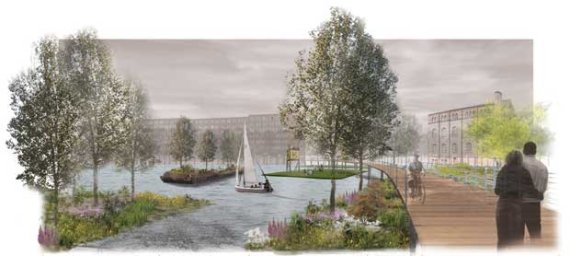In the north of Amsterdam across the IJ Channel lies the Buiksloterham industrial estate, a partly abandoned industrial area polluted with zinc, copper and other pollutants. The municipality’s plans to gradually transform the area and develop it into a housing estate with shops have been put on hold because of the crisis. In the meantime, Buiksloterham would be more appealing if you planted a lot of greenery there, thought two Wageningen students of Landscape Architecture. And this was just the beginning of their aspirations. In their final year design, Pieter Theuws and Mark Wilschut put vegetation to work, making use of the capacity of some trees to clean up soil pollution in a process known as phytoremediation. This works in various ways: the trees’ roots can prevent pollutants from leaching out, they can absorb heavy metals and they can break down organic matter. There are advantages to this compared with industrial removal, says Ingrid Duchhart, assistant professor of Landscape Architecture and the pair’s supervisor: ‘In this way, you can really solve the problem instead of just moving the soil elsewhere.’ It requires patience, however. According to Duchhart, it takes about 45 to 100 years before soil can be cleaned by plants. For the time being, this plan exists mainly on paper. But having won the Amsterdam Municipality competition, the phytoremediation idea will soon be applied in a small area. The plan is to turn a former shipyard called Ceuvel de Volharding into a breeding ground for creative entrepreneurs. So over the coming ten years, while plants extract poison from the soil there, creative souls will work in houseboats grounded on the terrain. Since the biochemistry process goes on at a slow pace, the objectives for these ten years are inevitably modest. ‘We don’t harbour any illusions that we can end up with a completely clean area,’ says Theuws. The main aim is for the shipyard to show that the approach is feasible. ‘Meanwhile, we are making plans for other unused parts of Amsterdam and other cities.’ The design will soon be featured in the Environmental pollution journal. RRPlanting against pollution Students win competition with plan for natural purification. Amsterdam plan should show this approach is feasible. In the north of Amsterdam across the IJ Channel lies the Buiksloterham industrial estate, a partly abandoned industrial area polluted with zinc, copper and other pollutants. The municipality’s plans to gradually transform the area and develop it into a housing estate with shops have been put on hold because of the crisis. In the meantime, Buiksloterham would be more appealing if you planted a lot of greenery there, thought two Wageningen students of Landscape Architecture. And this was just the beginning of their aspirations. In their final year design, Pieter Theuws and Mark Wilschut put vegetation to work, making use of the capacity of some trees to clean up soil pollution in a process known as phytoremediation. This works in various ways: the trees’ roots can prevent pollutants from leaching out, they can absorb heavy metals and they can break down organic matter. There are advantages to this compared with industrial removal, says Ingrid Duchhart, assistant professor of Landscape Architecture and the pair’s supervisor: ‘In this way, you can really solve the problem instead of just moving the soil elsewhere.’ It requires patience, however. According to Duchhart, it takes about 45 to 100 years before soil can be cleaned by plants. For the time being, this plan exists mainly on paper. But having won the Amsterdam Municipality competition, the phytoremediation idea will soon be applied in a small area. The plan is to turn a former shipyard called Ceuvel de Volharding into a breeding ground for creative entrepreneurs. So over the coming ten years, while plants extract poison from the soil there, creative souls will work in houseboats grounded on the terrain. Since the biochemistry process goes on at a slow pace, the objectives for these ten years are inevitably modest. ‘We don’t harbour any illusions that we can end up with a completely clean area,’ says Theuws. The main aim is for the shipyard to show that the approach is feasible. ‘Meanwhile, we are making plans for other unused parts of Amsterdam and other cities.’ The design will soon be featured in the Environmental pollution journal.
Planting against pollution
Students win competition with plan for natural purification.Amsterdam plan should show this approach is feasible.

